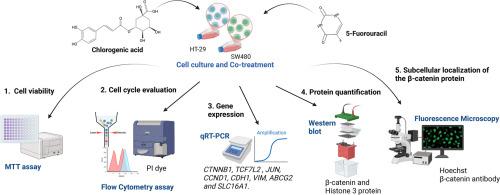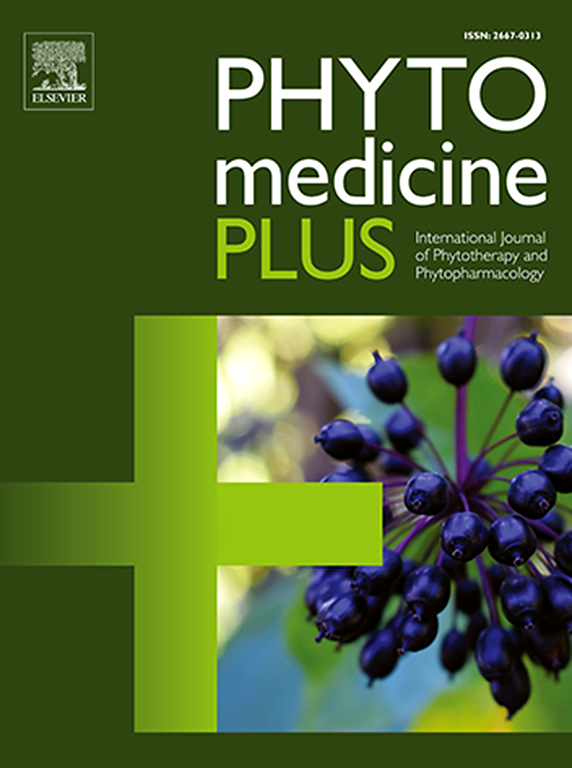绿原酸与5-氟尿嘧啶联合治疗Wnt/β-catenin通路调节对结直肠癌的治疗潜力
Q3 Pharmacology, Toxicology and Pharmaceutics
引用次数: 0
摘要
结直肠癌(CRC)由于其发病率和死亡率不断上升,已成为一个重要的公共卫生问题。鉴于化疗的局限性,探索新的治疗策略是必不可少的。Wnt/β-catenin通路在结直肠癌中经常被解除调控,促进其发展和进展。绿原酸在这一途径中具有良好的调节作用。目的本研究评价绿原酸联合化疗药物5-氟尿嘧啶对细胞活力和增殖的影响,以及对Wnt/β-catenin通路的调节。研究设计对结直肠癌细胞系SW480和HT-29进行联合治疗。这两个品系都表现出APC基因的改变,APC基因是Wnt/β-catenin通路的关键组成部分;然而,SW480显示出更高的通路转录活性。方法采用细胞生物学和分子生物学技术进行研究。MTT法用于评估细胞活力,而流式细胞术用于分析细胞周期进展,作为细胞增殖的衡量标准。采用qRT-PCR定量分析Wnt/β-catenin信号通路相关基因及其靶基因的表达。Western blotting检测β-catenin蛋白水平,荧光显微镜检测β-catenin的荧光强度和细胞定位。结果共处理降低了两种细胞系的细胞活力,改变了细胞周期,其中SW480细胞表现出更高的敏感性。此外,还观察到通路相关基因表达水平的差异调节,包括β-catenin和TCF7L2的降低。与耐药和肿瘤代谢相关的基因表达也发生了变化,HT-29中ABCG2和SW480中SLC16A1的表达均显著降低。结论绿原酸通过调节Wnt/β-catenin通路增强常规治疗的疗效,可能影响结直肠癌的癌变过程。本文章由计算机程序翻译,如有差异,请以英文原文为准。

Therapeutic potential of combined treatment with chlorogenic acid and 5-fluorouracil in colorectal cancer through Wnt/β-catenin pathway modulation
Background
Colorectal cancer (CRC) has become a significant public health concern due to its rising incidence and mortality rates. Given the limitations of chemotherapy, exploring novel therapeutic strategies is essential. The Wnt/β-catenin pathway is often deregulated in CRC, contributing to its development and progression. Chlorogenic acid has demonstrated a promising modulatory effect on this pathway.
Purpose
In this context, this study evaluated the effect of chlorogenic acid in combination with the chemotherapeutic 5-fluorouracil on cell viability and proliferation, as well as on the modulation of the Wnt/β-catenin pathway.
Study design
Combined treatments were performed on CRC cell lines SW480 and HT-29. Both lines exhibit alterations in the APC gene, a key component of the Wnt/β-catenin pathway; however, SW480 displays higher transcriptional activity of the pathway.
Methods
Cellular and molecular biology techniques were employed in this study. The MTT assay was used to assess cell viability, while flow cytometry was used to analyze cell cycle progression as a measure of cellular proliferation. qRT-PCR was conducted to quantify the expression of genes involved in the Wnt/β-catenin signaling pathway and its target genes. Western blotting was performed to measure β-catenin protein levels, and fluorescence microscopy was applied to evaluate the fluorescence intensity and cellular localization of β-catenin.
Results
The results showed that co-treatment decreased cell viability and altered the cycle in both lines, with SW480 cells showing greater sensitivity. Furthermore, differential modulation of pathway-related gene expression levels was observed, including decreased β-catenin and TCF7L2. Changes in the expression of genes associated with drug resistance and tumor metabolism were also identified, significant decreases of ABCG2 in HT-29 and of SLC16A1 in SW480.
Conclusion
The results suggest that chlorogenic acid enhances the efficacy of conventional therapy by modulating the Wnt/β-catenin pathway, which could potentially impact the carcinogenesis of CRC.
求助全文
通过发布文献求助,成功后即可免费获取论文全文。
去求助
来源期刊

Phytomedicine Plus
Medicine-Complementary and Alternative Medicine
CiteScore
3.70
自引率
0.00%
发文量
178
审稿时长
81 days
期刊介绍:
 求助内容:
求助内容: 应助结果提醒方式:
应助结果提醒方式:


